Evaluating Treatment Effectiveness for Tremor Conditions
VerifiedAdded on 2020/05/04
|14
|3214
|98
AI Summary
The exploration of tremor treatment research reveals significant insights into managing conditions such as Parkinson's Disease (PD) and Essential Tremor (ET). Pharmacological interventions remain a cornerstone for PD management, but their efficacy in ET is limited to beta-blockers like propranolol. Side effects often necessitate alternative treatments. Neuroprosthetic devices offer innovative solutions by utilizing electrical stimulation to counteract tremors based on real-time physiological feedback. Deep Brain Stimulation (DBS) has shown promise, particularly for severe cases of PD and ET, though it carries risks such as surgical complications and infection. Current research is directed towards refining these technologies and exploring new therapeutic targets like the subthalamic nucleus, which may provide improved outcomes with fewer side effects.
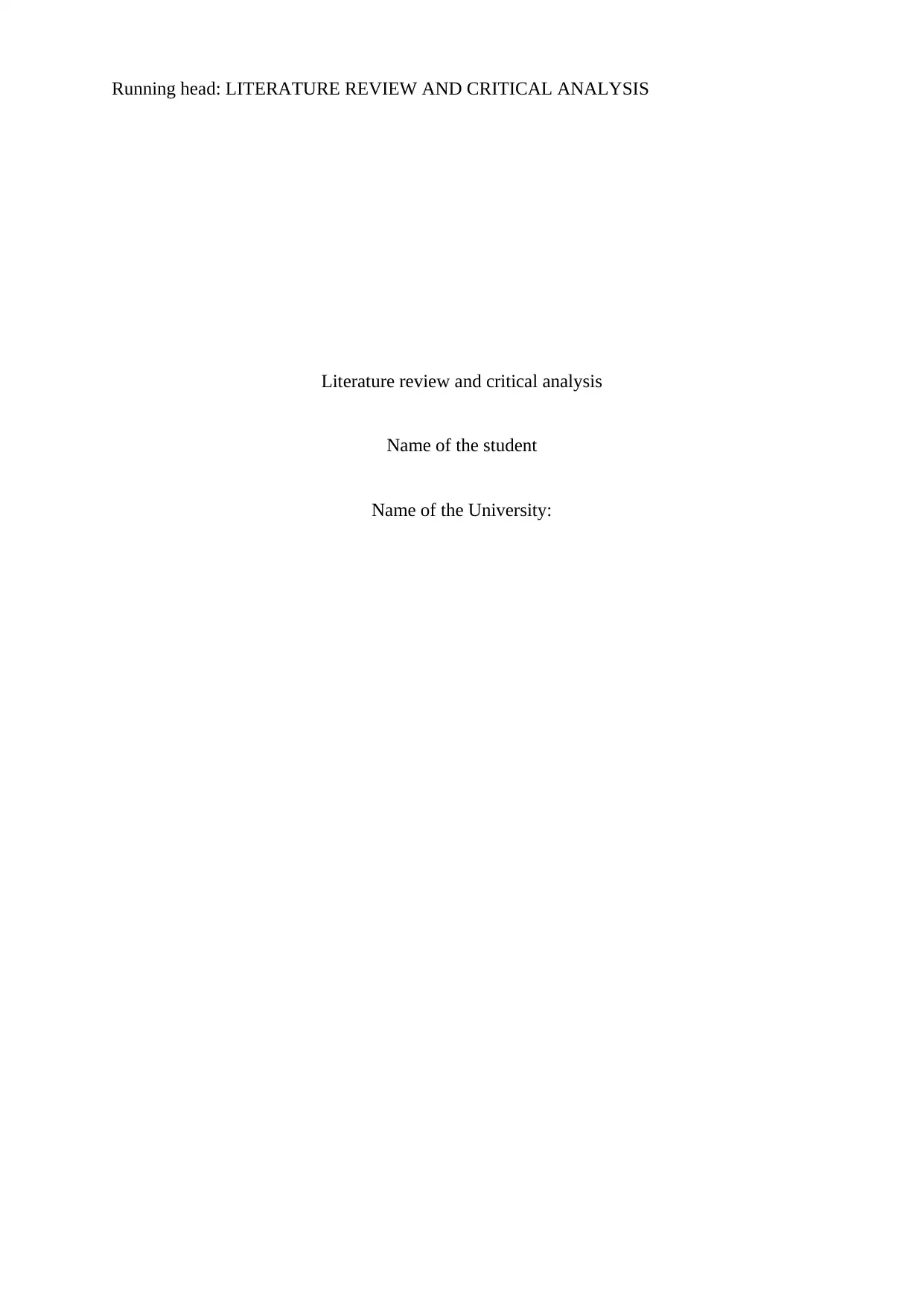
Running head: LITERATURE REVIEW AND CRITICAL ANALYSIS
Literature review and critical analysis
Name of the student
Name of the University:
Literature review and critical analysis
Name of the student
Name of the University:
Paraphrase This Document
Need a fresh take? Get an instant paraphrase of this document with our AI Paraphraser
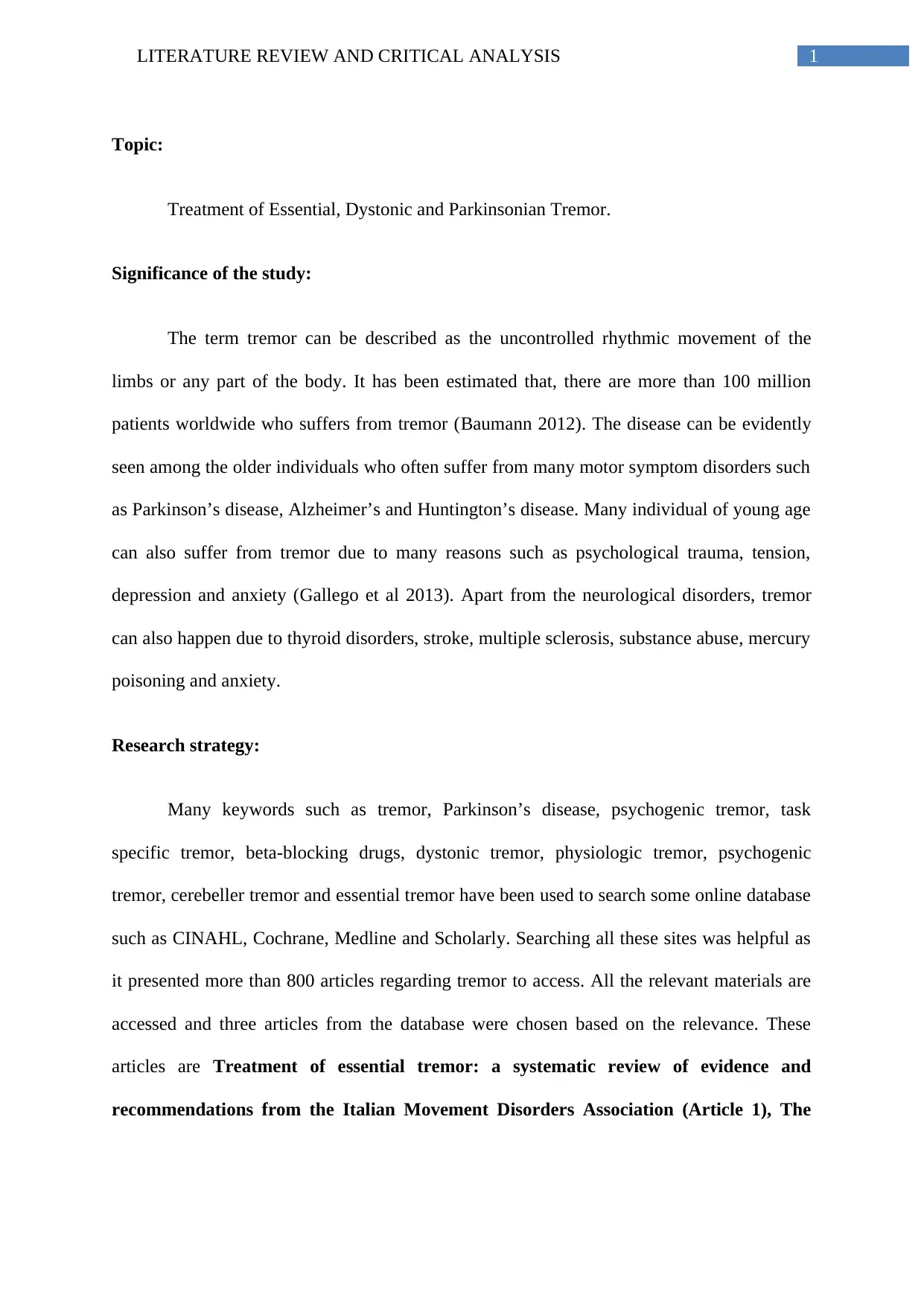
1LITERATURE REVIEW AND CRITICAL ANALYSIS
Topic:
Treatment of Essential, Dystonic and Parkinsonian Tremor.
Significance of the study:
The term tremor can be described as the uncontrolled rhythmic movement of the
limbs or any part of the body. It has been estimated that, there are more than 100 million
patients worldwide who suffers from tremor (Baumann 2012). The disease can be evidently
seen among the older individuals who often suffer from many motor symptom disorders such
as Parkinson’s disease, Alzheimer’s and Huntington’s disease. Many individual of young age
can also suffer from tremor due to many reasons such as psychological trauma, tension,
depression and anxiety (Gallego et al 2013). Apart from the neurological disorders, tremor
can also happen due to thyroid disorders, stroke, multiple sclerosis, substance abuse, mercury
poisoning and anxiety.
Research strategy:
Many keywords such as tremor, Parkinson’s disease, psychogenic tremor, task
specific tremor, beta-blocking drugs, dystonic tremor, physiologic tremor, psychogenic
tremor, cerebeller tremor and essential tremor have been used to search some online database
such as CINAHL, Cochrane, Medline and Scholarly. Searching all these sites was helpful as
it presented more than 800 articles regarding tremor to access. All the relevant materials are
accessed and three articles from the database were chosen based on the relevance. These
articles are Treatment of essential tremor: a systematic review of evidence and
recommendations from the Italian Movement Disorders Association (Article 1), The
Topic:
Treatment of Essential, Dystonic and Parkinsonian Tremor.
Significance of the study:
The term tremor can be described as the uncontrolled rhythmic movement of the
limbs or any part of the body. It has been estimated that, there are more than 100 million
patients worldwide who suffers from tremor (Baumann 2012). The disease can be evidently
seen among the older individuals who often suffer from many motor symptom disorders such
as Parkinson’s disease, Alzheimer’s and Huntington’s disease. Many individual of young age
can also suffer from tremor due to many reasons such as psychological trauma, tension,
depression and anxiety (Gallego et al 2013). Apart from the neurological disorders, tremor
can also happen due to thyroid disorders, stroke, multiple sclerosis, substance abuse, mercury
poisoning and anxiety.
Research strategy:
Many keywords such as tremor, Parkinson’s disease, psychogenic tremor, task
specific tremor, beta-blocking drugs, dystonic tremor, physiologic tremor, psychogenic
tremor, cerebeller tremor and essential tremor have been used to search some online database
such as CINAHL, Cochrane, Medline and Scholarly. Searching all these sites was helpful as
it presented more than 800 articles regarding tremor to access. All the relevant materials are
accessed and three articles from the database were chosen based on the relevance. These
articles are Treatment of essential tremor: a systematic review of evidence and
recommendations from the Italian Movement Disorders Association (Article 1), The
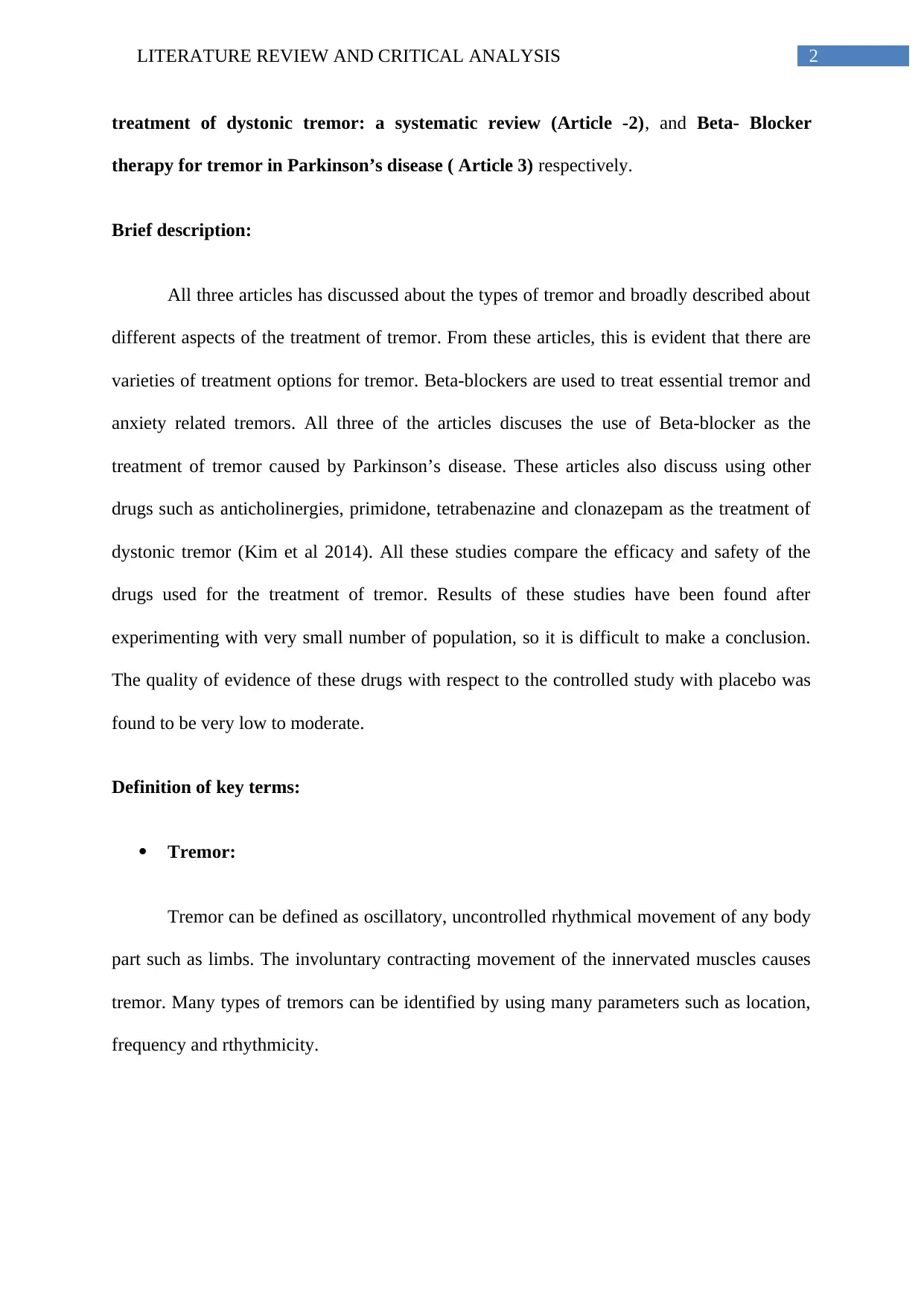
2LITERATURE REVIEW AND CRITICAL ANALYSIS
treatment of dystonic tremor: a systematic review (Article -2), and Beta- Blocker
therapy for tremor in Parkinson’s disease ( Article 3) respectively.
Brief description:
All three articles has discussed about the types of tremor and broadly described about
different aspects of the treatment of tremor. From these articles, this is evident that there are
varieties of treatment options for tremor. Beta-blockers are used to treat essential tremor and
anxiety related tremors. All three of the articles discuses the use of Beta-blocker as the
treatment of tremor caused by Parkinson’s disease. These articles also discuss using other
drugs such as anticholinergies, primidone, tetrabenazine and clonazepam as the treatment of
dystonic tremor (Kim et al 2014). All these studies compare the efficacy and safety of the
drugs used for the treatment of tremor. Results of these studies have been found after
experimenting with very small number of population, so it is difficult to make a conclusion.
The quality of evidence of these drugs with respect to the controlled study with placebo was
found to be very low to moderate.
Definition of key terms:
Tremor:
Tremor can be defined as oscillatory, uncontrolled rhythmical movement of any body
part such as limbs. The involuntary contracting movement of the innervated muscles causes
tremor. Many types of tremors can be identified by using many parameters such as location,
frequency and rthythmicity.
treatment of dystonic tremor: a systematic review (Article -2), and Beta- Blocker
therapy for tremor in Parkinson’s disease ( Article 3) respectively.
Brief description:
All three articles has discussed about the types of tremor and broadly described about
different aspects of the treatment of tremor. From these articles, this is evident that there are
varieties of treatment options for tremor. Beta-blockers are used to treat essential tremor and
anxiety related tremors. All three of the articles discuses the use of Beta-blocker as the
treatment of tremor caused by Parkinson’s disease. These articles also discuss using other
drugs such as anticholinergies, primidone, tetrabenazine and clonazepam as the treatment of
dystonic tremor (Kim et al 2014). All these studies compare the efficacy and safety of the
drugs used for the treatment of tremor. Results of these studies have been found after
experimenting with very small number of population, so it is difficult to make a conclusion.
The quality of evidence of these drugs with respect to the controlled study with placebo was
found to be very low to moderate.
Definition of key terms:
Tremor:
Tremor can be defined as oscillatory, uncontrolled rhythmical movement of any body
part such as limbs. The involuntary contracting movement of the innervated muscles causes
tremor. Many types of tremors can be identified by using many parameters such as location,
frequency and rthythmicity.
⊘ This is a preview!⊘
Do you want full access?
Subscribe today to unlock all pages.

Trusted by 1+ million students worldwide
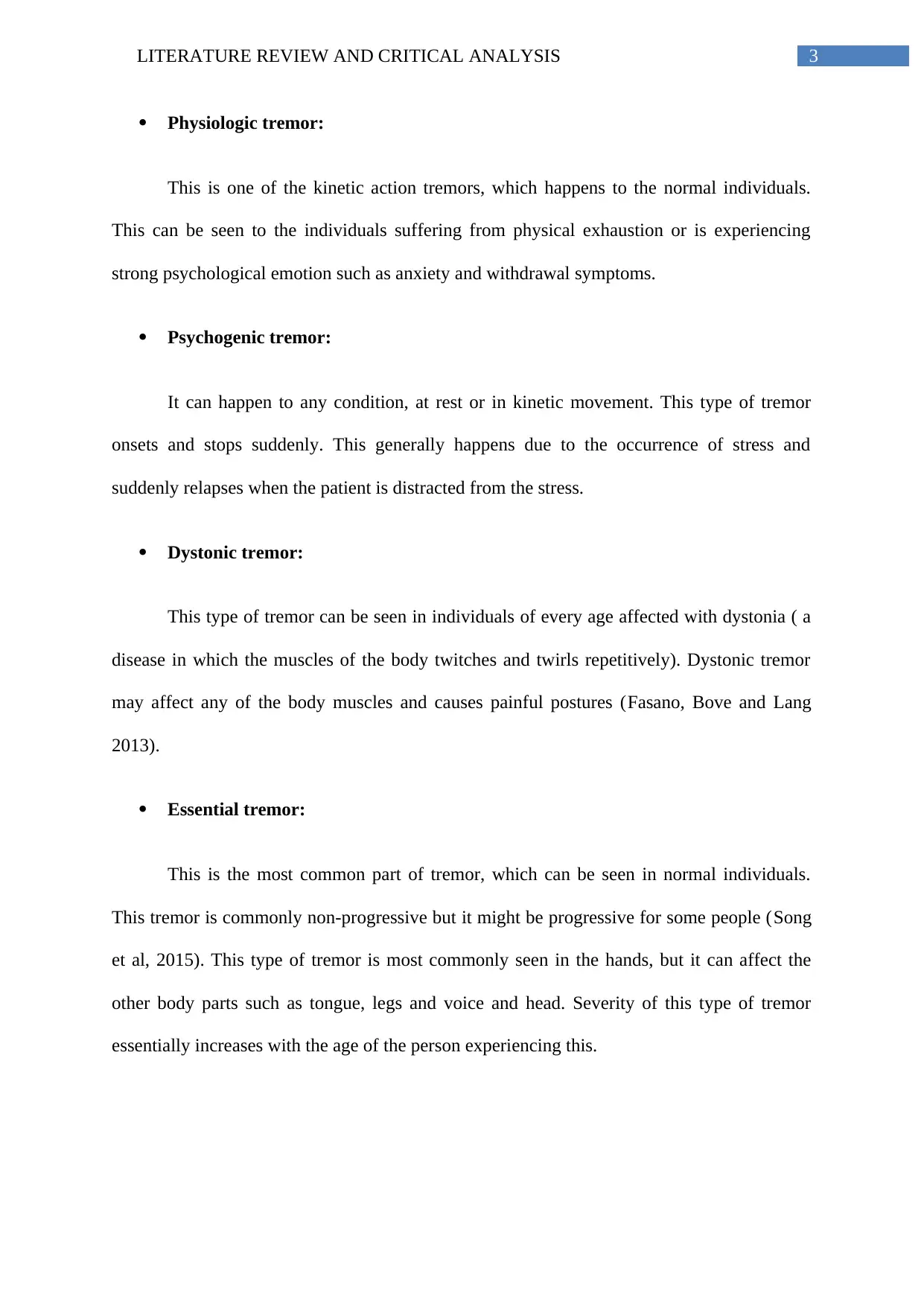
3LITERATURE REVIEW AND CRITICAL ANALYSIS
Physiologic tremor:
This is one of the kinetic action tremors, which happens to the normal individuals.
This can be seen to the individuals suffering from physical exhaustion or is experiencing
strong psychological emotion such as anxiety and withdrawal symptoms.
Psychogenic tremor:
It can happen to any condition, at rest or in kinetic movement. This type of tremor
onsets and stops suddenly. This generally happens due to the occurrence of stress and
suddenly relapses when the patient is distracted from the stress.
Dystonic tremor:
This type of tremor can be seen in individuals of every age affected with dystonia ( a
disease in which the muscles of the body twitches and twirls repetitively). Dystonic tremor
may affect any of the body muscles and causes painful postures (Fasano, Bove and Lang
2013).
Essential tremor:
This is the most common part of tremor, which can be seen in normal individuals.
This tremor is commonly non-progressive but it might be progressive for some people (Song
et al, 2015). This type of tremor is most commonly seen in the hands, but it can affect the
other body parts such as tongue, legs and voice and head. Severity of this type of tremor
essentially increases with the age of the person experiencing this.
Physiologic tremor:
This is one of the kinetic action tremors, which happens to the normal individuals.
This can be seen to the individuals suffering from physical exhaustion or is experiencing
strong psychological emotion such as anxiety and withdrawal symptoms.
Psychogenic tremor:
It can happen to any condition, at rest or in kinetic movement. This type of tremor
onsets and stops suddenly. This generally happens due to the occurrence of stress and
suddenly relapses when the patient is distracted from the stress.
Dystonic tremor:
This type of tremor can be seen in individuals of every age affected with dystonia ( a
disease in which the muscles of the body twitches and twirls repetitively). Dystonic tremor
may affect any of the body muscles and causes painful postures (Fasano, Bove and Lang
2013).
Essential tremor:
This is the most common part of tremor, which can be seen in normal individuals.
This tremor is commonly non-progressive but it might be progressive for some people (Song
et al, 2015). This type of tremor is most commonly seen in the hands, but it can affect the
other body parts such as tongue, legs and voice and head. Severity of this type of tremor
essentially increases with the age of the person experiencing this.
Paraphrase This Document
Need a fresh take? Get an instant paraphrase of this document with our AI Paraphraser
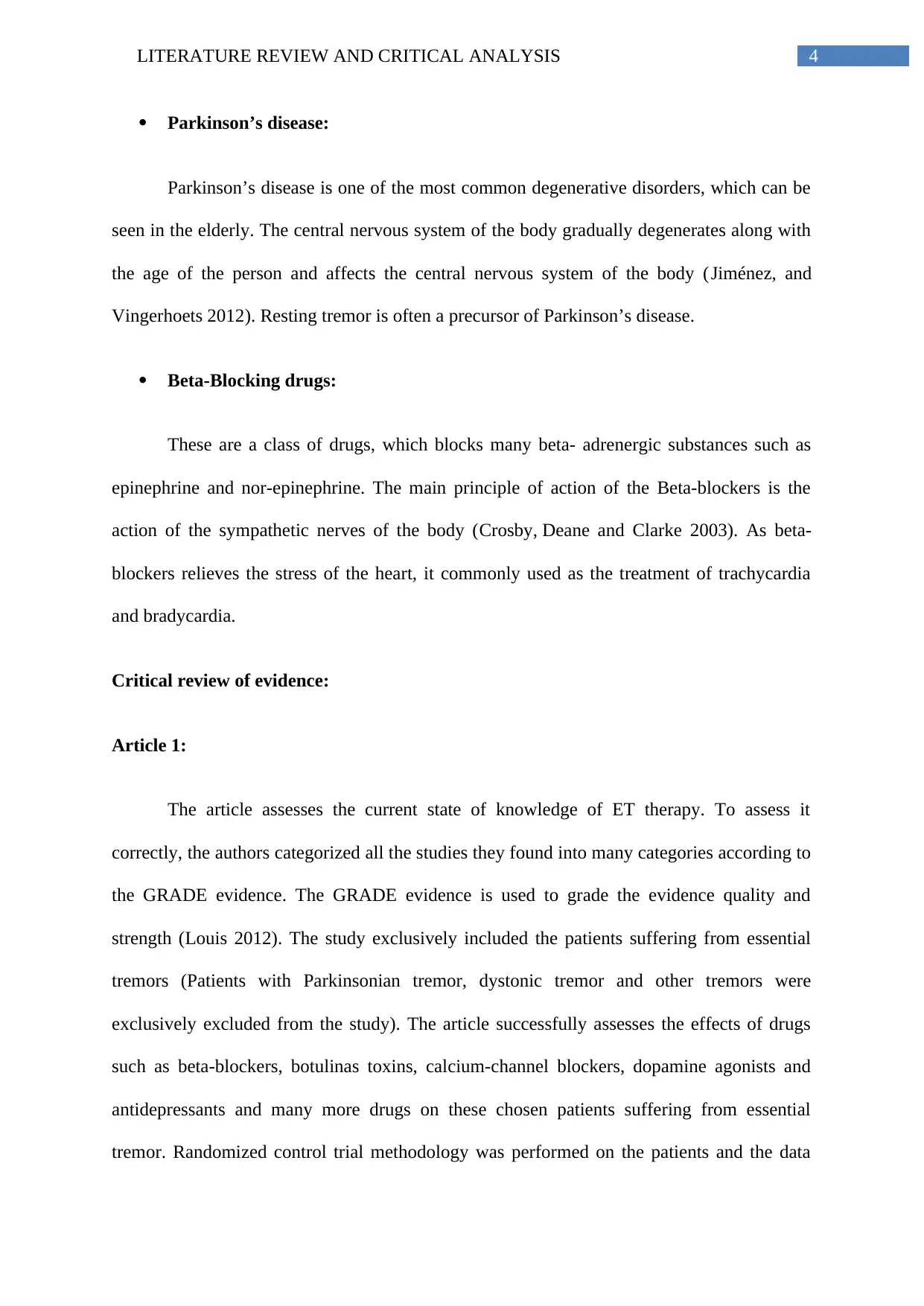
4LITERATURE REVIEW AND CRITICAL ANALYSIS
Parkinson’s disease:
Parkinson’s disease is one of the most common degenerative disorders, which can be
seen in the elderly. The central nervous system of the body gradually degenerates along with
the age of the person and affects the central nervous system of the body (Jiménez, and
Vingerhoets 2012). Resting tremor is often a precursor of Parkinson’s disease.
Beta-Blocking drugs:
These are a class of drugs, which blocks many beta- adrenergic substances such as
epinephrine and nor-epinephrine. The main principle of action of the Beta-blockers is the
action of the sympathetic nerves of the body (Crosby, Deane and Clarke 2003). As beta-
blockers relieves the stress of the heart, it commonly used as the treatment of trachycardia
and bradycardia.
Critical review of evidence:
Article 1:
The article assesses the current state of knowledge of ET therapy. To assess it
correctly, the authors categorized all the studies they found into many categories according to
the GRADE evidence. The GRADE evidence is used to grade the evidence quality and
strength (Louis 2012). The study exclusively included the patients suffering from essential
tremors (Patients with Parkinsonian tremor, dystonic tremor and other tremors were
exclusively excluded from the study). The article successfully assesses the effects of drugs
such as beta-blockers, botulinas toxins, calcium-channel blockers, dopamine agonists and
antidepressants and many more drugs on these chosen patients suffering from essential
tremor. Randomized control trial methodology was performed on the patients and the data
Parkinson’s disease:
Parkinson’s disease is one of the most common degenerative disorders, which can be
seen in the elderly. The central nervous system of the body gradually degenerates along with
the age of the person and affects the central nervous system of the body (Jiménez, and
Vingerhoets 2012). Resting tremor is often a precursor of Parkinson’s disease.
Beta-Blocking drugs:
These are a class of drugs, which blocks many beta- adrenergic substances such as
epinephrine and nor-epinephrine. The main principle of action of the Beta-blockers is the
action of the sympathetic nerves of the body (Crosby, Deane and Clarke 2003). As beta-
blockers relieves the stress of the heart, it commonly used as the treatment of trachycardia
and bradycardia.
Critical review of evidence:
Article 1:
The article assesses the current state of knowledge of ET therapy. To assess it
correctly, the authors categorized all the studies they found into many categories according to
the GRADE evidence. The GRADE evidence is used to grade the evidence quality and
strength (Louis 2012). The study exclusively included the patients suffering from essential
tremors (Patients with Parkinsonian tremor, dystonic tremor and other tremors were
exclusively excluded from the study). The article successfully assesses the effects of drugs
such as beta-blockers, botulinas toxins, calcium-channel blockers, dopamine agonists and
antidepressants and many more drugs on these chosen patients suffering from essential
tremor. Randomized control trial methodology was performed on the patients and the data
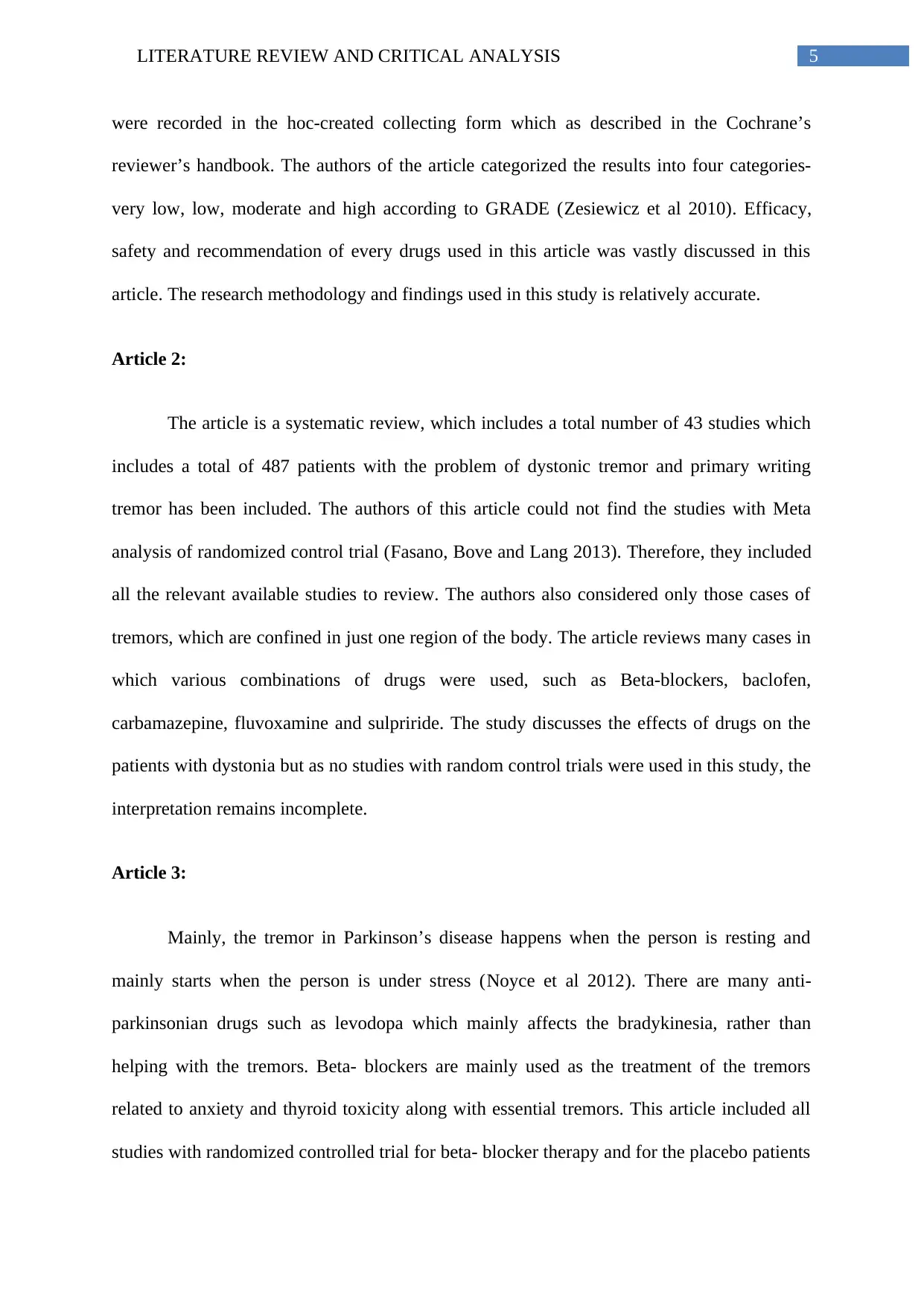
5LITERATURE REVIEW AND CRITICAL ANALYSIS
were recorded in the hoc-created collecting form which as described in the Cochrane’s
reviewer’s handbook. The authors of the article categorized the results into four categories-
very low, low, moderate and high according to GRADE (Zesiewicz et al 2010). Efficacy,
safety and recommendation of every drugs used in this article was vastly discussed in this
article. The research methodology and findings used in this study is relatively accurate.
Article 2:
The article is a systematic review, which includes a total number of 43 studies which
includes a total of 487 patients with the problem of dystonic tremor and primary writing
tremor has been included. The authors of this article could not find the studies with Meta
analysis of randomized control trial (Fasano, Bove and Lang 2013). Therefore, they included
all the relevant available studies to review. The authors also considered only those cases of
tremors, which are confined in just one region of the body. The article reviews many cases in
which various combinations of drugs were used, such as Beta-blockers, baclofen,
carbamazepine, fluvoxamine and sulpriride. The study discusses the effects of drugs on the
patients with dystonia but as no studies with random control trials were used in this study, the
interpretation remains incomplete.
Article 3:
Mainly, the tremor in Parkinson’s disease happens when the person is resting and
mainly starts when the person is under stress (Noyce et al 2012). There are many anti-
parkinsonian drugs such as levodopa which mainly affects the bradykinesia, rather than
helping with the tremors. Beta- blockers are mainly used as the treatment of the tremors
related to anxiety and thyroid toxicity along with essential tremors. This article included all
studies with randomized controlled trial for beta- blocker therapy and for the placebo patients
were recorded in the hoc-created collecting form which as described in the Cochrane’s
reviewer’s handbook. The authors of the article categorized the results into four categories-
very low, low, moderate and high according to GRADE (Zesiewicz et al 2010). Efficacy,
safety and recommendation of every drugs used in this article was vastly discussed in this
article. The research methodology and findings used in this study is relatively accurate.
Article 2:
The article is a systematic review, which includes a total number of 43 studies which
includes a total of 487 patients with the problem of dystonic tremor and primary writing
tremor has been included. The authors of this article could not find the studies with Meta
analysis of randomized control trial (Fasano, Bove and Lang 2013). Therefore, they included
all the relevant available studies to review. The authors also considered only those cases of
tremors, which are confined in just one region of the body. The article reviews many cases in
which various combinations of drugs were used, such as Beta-blockers, baclofen,
carbamazepine, fluvoxamine and sulpriride. The study discusses the effects of drugs on the
patients with dystonia but as no studies with random control trials were used in this study, the
interpretation remains incomplete.
Article 3:
Mainly, the tremor in Parkinson’s disease happens when the person is resting and
mainly starts when the person is under stress (Noyce et al 2012). There are many anti-
parkinsonian drugs such as levodopa which mainly affects the bradykinesia, rather than
helping with the tremors. Beta- blockers are mainly used as the treatment of the tremors
related to anxiety and thyroid toxicity along with essential tremors. This article included all
studies with randomized controlled trial for beta- blocker therapy and for the placebo patients
⊘ This is a preview!⊘
Do you want full access?
Subscribe today to unlock all pages.

Trusted by 1+ million students worldwide
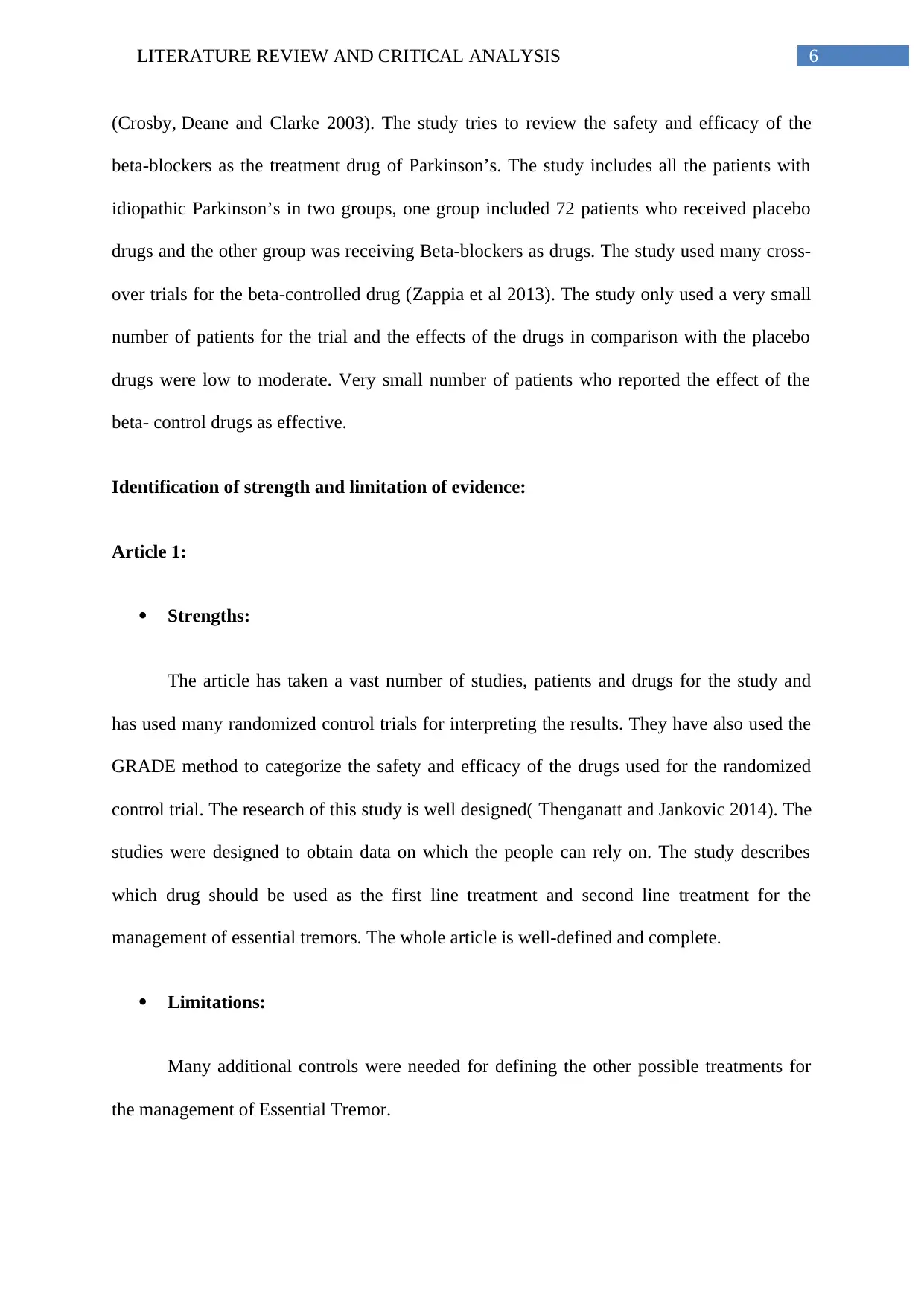
6LITERATURE REVIEW AND CRITICAL ANALYSIS
(Crosby, Deane and Clarke 2003). The study tries to review the safety and efficacy of the
beta-blockers as the treatment drug of Parkinson’s. The study includes all the patients with
idiopathic Parkinson’s in two groups, one group included 72 patients who received placebo
drugs and the other group was receiving Beta-blockers as drugs. The study used many cross-
over trials for the beta-controlled drug (Zappia et al 2013). The study only used a very small
number of patients for the trial and the effects of the drugs in comparison with the placebo
drugs were low to moderate. Very small number of patients who reported the effect of the
beta- control drugs as effective.
Identification of strength and limitation of evidence:
Article 1:
Strengths:
The article has taken a vast number of studies, patients and drugs for the study and
has used many randomized control trials for interpreting the results. They have also used the
GRADE method to categorize the safety and efficacy of the drugs used for the randomized
control trial. The research of this study is well designed( Thenganatt and Jankovic 2014). The
studies were designed to obtain data on which the people can rely on. The study describes
which drug should be used as the first line treatment and second line treatment for the
management of essential tremors. The whole article is well-defined and complete.
Limitations:
Many additional controls were needed for defining the other possible treatments for
the management of Essential Tremor.
(Crosby, Deane and Clarke 2003). The study tries to review the safety and efficacy of the
beta-blockers as the treatment drug of Parkinson’s. The study includes all the patients with
idiopathic Parkinson’s in two groups, one group included 72 patients who received placebo
drugs and the other group was receiving Beta-blockers as drugs. The study used many cross-
over trials for the beta-controlled drug (Zappia et al 2013). The study only used a very small
number of patients for the trial and the effects of the drugs in comparison with the placebo
drugs were low to moderate. Very small number of patients who reported the effect of the
beta- control drugs as effective.
Identification of strength and limitation of evidence:
Article 1:
Strengths:
The article has taken a vast number of studies, patients and drugs for the study and
has used many randomized control trials for interpreting the results. They have also used the
GRADE method to categorize the safety and efficacy of the drugs used for the randomized
control trial. The research of this study is well designed( Thenganatt and Jankovic 2014). The
studies were designed to obtain data on which the people can rely on. The study describes
which drug should be used as the first line treatment and second line treatment for the
management of essential tremors. The whole article is well-defined and complete.
Limitations:
Many additional controls were needed for defining the other possible treatments for
the management of Essential Tremor.
Paraphrase This Document
Need a fresh take? Get an instant paraphrase of this document with our AI Paraphraser
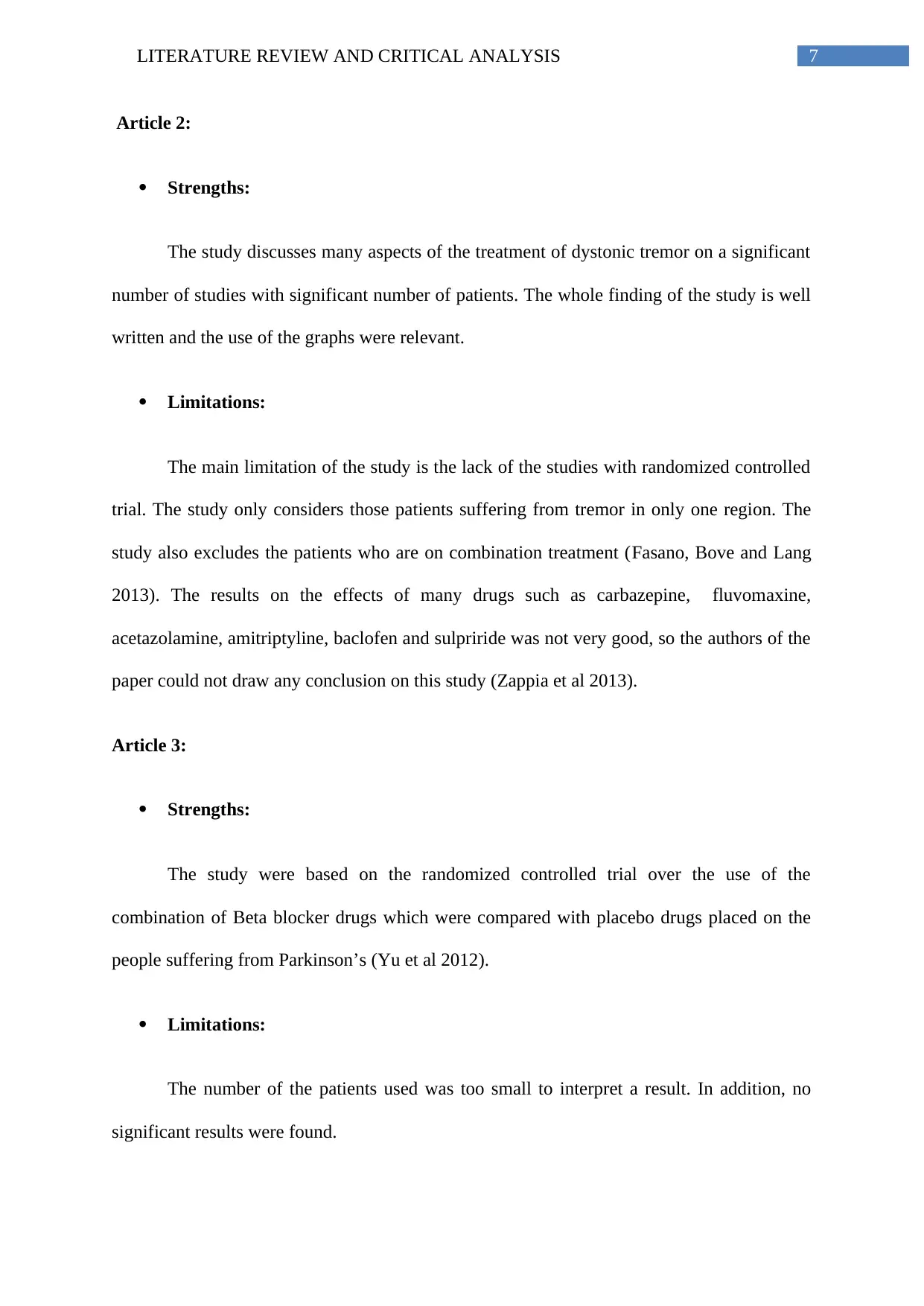
7LITERATURE REVIEW AND CRITICAL ANALYSIS
Article 2:
Strengths:
The study discusses many aspects of the treatment of dystonic tremor on a significant
number of studies with significant number of patients. The whole finding of the study is well
written and the use of the graphs were relevant.
Limitations:
The main limitation of the study is the lack of the studies with randomized controlled
trial. The study only considers those patients suffering from tremor in only one region. The
study also excludes the patients who are on combination treatment (Fasano, Bove and Lang
2013). The results on the effects of many drugs such as carbazepine, fluvomaxine,
acetazolamine, amitriptyline, baclofen and sulpriride was not very good, so the authors of the
paper could not draw any conclusion on this study (Zappia et al 2013).
Article 3:
Strengths:
The study were based on the randomized controlled trial over the use of the
combination of Beta blocker drugs which were compared with placebo drugs placed on the
people suffering from Parkinson’s (Yu et al 2012).
Limitations:
The number of the patients used was too small to interpret a result. In addition, no
significant results were found.
Article 2:
Strengths:
The study discusses many aspects of the treatment of dystonic tremor on a significant
number of studies with significant number of patients. The whole finding of the study is well
written and the use of the graphs were relevant.
Limitations:
The main limitation of the study is the lack of the studies with randomized controlled
trial. The study only considers those patients suffering from tremor in only one region. The
study also excludes the patients who are on combination treatment (Fasano, Bove and Lang
2013). The results on the effects of many drugs such as carbazepine, fluvomaxine,
acetazolamine, amitriptyline, baclofen and sulpriride was not very good, so the authors of the
paper could not draw any conclusion on this study (Zappia et al 2013).
Article 3:
Strengths:
The study were based on the randomized controlled trial over the use of the
combination of Beta blocker drugs which were compared with placebo drugs placed on the
people suffering from Parkinson’s (Yu et al 2012).
Limitations:
The number of the patients used was too small to interpret a result. In addition, no
significant results were found.
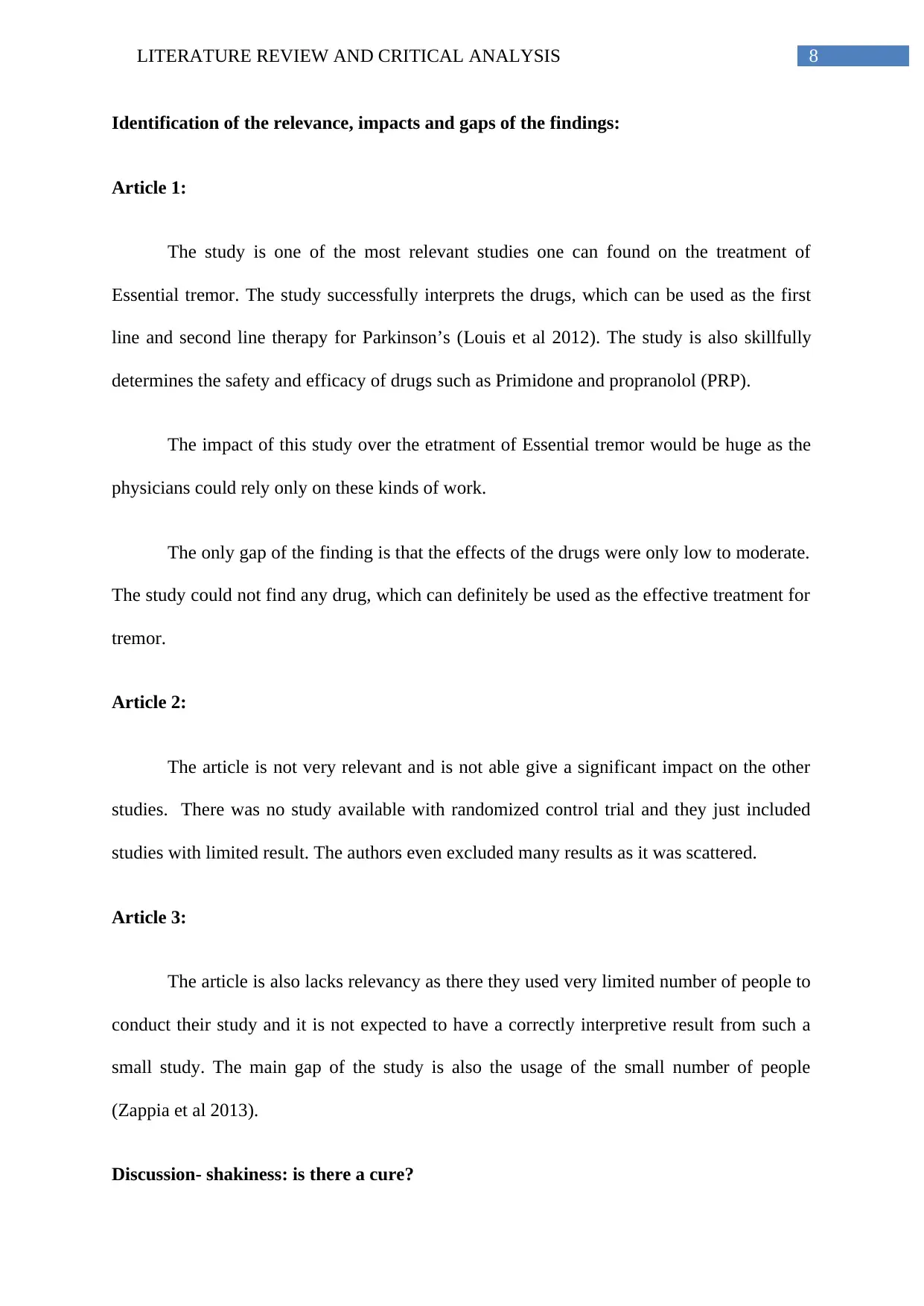
8LITERATURE REVIEW AND CRITICAL ANALYSIS
Identification of the relevance, impacts and gaps of the findings:
Article 1:
The study is one of the most relevant studies one can found on the treatment of
Essential tremor. The study successfully interprets the drugs, which can be used as the first
line and second line therapy for Parkinson’s (Louis et al 2012). The study is also skillfully
determines the safety and efficacy of drugs such as Primidone and propranolol (PRP).
The impact of this study over the etratment of Essential tremor would be huge as the
physicians could rely only on these kinds of work.
The only gap of the finding is that the effects of the drugs were only low to moderate.
The study could not find any drug, which can definitely be used as the effective treatment for
tremor.
Article 2:
The article is not very relevant and is not able give a significant impact on the other
studies. There was no study available with randomized control trial and they just included
studies with limited result. The authors even excluded many results as it was scattered.
Article 3:
The article is also lacks relevancy as there they used very limited number of people to
conduct their study and it is not expected to have a correctly interpretive result from such a
small study. The main gap of the study is also the usage of the small number of people
(Zappia et al 2013).
Discussion- shakiness: is there a cure?
Identification of the relevance, impacts and gaps of the findings:
Article 1:
The study is one of the most relevant studies one can found on the treatment of
Essential tremor. The study successfully interprets the drugs, which can be used as the first
line and second line therapy for Parkinson’s (Louis et al 2012). The study is also skillfully
determines the safety and efficacy of drugs such as Primidone and propranolol (PRP).
The impact of this study over the etratment of Essential tremor would be huge as the
physicians could rely only on these kinds of work.
The only gap of the finding is that the effects of the drugs were only low to moderate.
The study could not find any drug, which can definitely be used as the effective treatment for
tremor.
Article 2:
The article is not very relevant and is not able give a significant impact on the other
studies. There was no study available with randomized control trial and they just included
studies with limited result. The authors even excluded many results as it was scattered.
Article 3:
The article is also lacks relevancy as there they used very limited number of people to
conduct their study and it is not expected to have a correctly interpretive result from such a
small study. The main gap of the study is also the usage of the small number of people
(Zappia et al 2013).
Discussion- shakiness: is there a cure?
⊘ This is a preview!⊘
Do you want full access?
Subscribe today to unlock all pages.

Trusted by 1+ million students worldwide
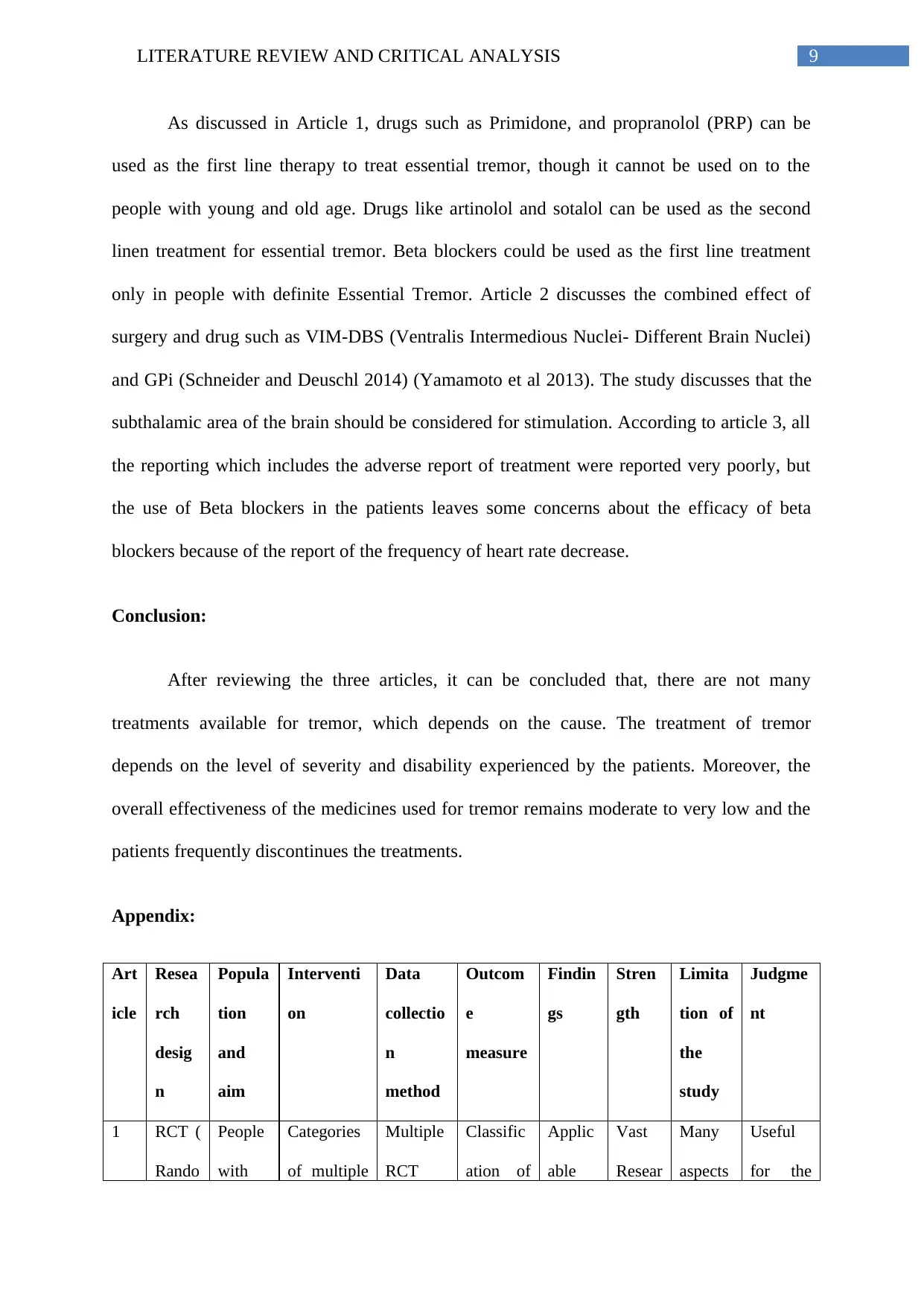
9LITERATURE REVIEW AND CRITICAL ANALYSIS
As discussed in Article 1, drugs such as Primidone, and propranolol (PRP) can be
used as the first line therapy to treat essential tremor, though it cannot be used on to the
people with young and old age. Drugs like artinolol and sotalol can be used as the second
linen treatment for essential tremor. Beta blockers could be used as the first line treatment
only in people with definite Essential Tremor. Article 2 discusses the combined effect of
surgery and drug such as VIM-DBS (Ventralis Intermedious Nuclei- Different Brain Nuclei)
and GPi (Schneider and Deuschl 2014) (Yamamoto et al 2013). The study discusses that the
subthalamic area of the brain should be considered for stimulation. According to article 3, all
the reporting which includes the adverse report of treatment were reported very poorly, but
the use of Beta blockers in the patients leaves some concerns about the efficacy of beta
blockers because of the report of the frequency of heart rate decrease.
Conclusion:
After reviewing the three articles, it can be concluded that, there are not many
treatments available for tremor, which depends on the cause. The treatment of tremor
depends on the level of severity and disability experienced by the patients. Moreover, the
overall effectiveness of the medicines used for tremor remains moderate to very low and the
patients frequently discontinues the treatments.
Appendix:
Art
icle
Resea
rch
desig
n
Popula
tion
and
aim
Interventi
on
Data
collectio
n
method
Outcom
e
measure
Findin
gs
Stren
gth
Limita
tion of
the
study
Judgme
nt
1 RCT (
Rando
People
with
Categories
of multiple
Multiple
RCT
Classific
ation of
Applic
able
Vast
Resear
Many
aspects
Useful
for the
As discussed in Article 1, drugs such as Primidone, and propranolol (PRP) can be
used as the first line therapy to treat essential tremor, though it cannot be used on to the
people with young and old age. Drugs like artinolol and sotalol can be used as the second
linen treatment for essential tremor. Beta blockers could be used as the first line treatment
only in people with definite Essential Tremor. Article 2 discusses the combined effect of
surgery and drug such as VIM-DBS (Ventralis Intermedious Nuclei- Different Brain Nuclei)
and GPi (Schneider and Deuschl 2014) (Yamamoto et al 2013). The study discusses that the
subthalamic area of the brain should be considered for stimulation. According to article 3, all
the reporting which includes the adverse report of treatment were reported very poorly, but
the use of Beta blockers in the patients leaves some concerns about the efficacy of beta
blockers because of the report of the frequency of heart rate decrease.
Conclusion:
After reviewing the three articles, it can be concluded that, there are not many
treatments available for tremor, which depends on the cause. The treatment of tremor
depends on the level of severity and disability experienced by the patients. Moreover, the
overall effectiveness of the medicines used for tremor remains moderate to very low and the
patients frequently discontinues the treatments.
Appendix:
Art
icle
Resea
rch
desig
n
Popula
tion
and
aim
Interventi
on
Data
collectio
n
method
Outcom
e
measure
Findin
gs
Stren
gth
Limita
tion of
the
study
Judgme
nt
1 RCT (
Rando
People
with
Categories
of multiple
Multiple
RCT
Classific
ation of
Applic
able
Vast
Resear
Many
aspects
Useful
for the
Paraphrase This Document
Need a fresh take? Get an instant paraphrase of this document with our AI Paraphraser
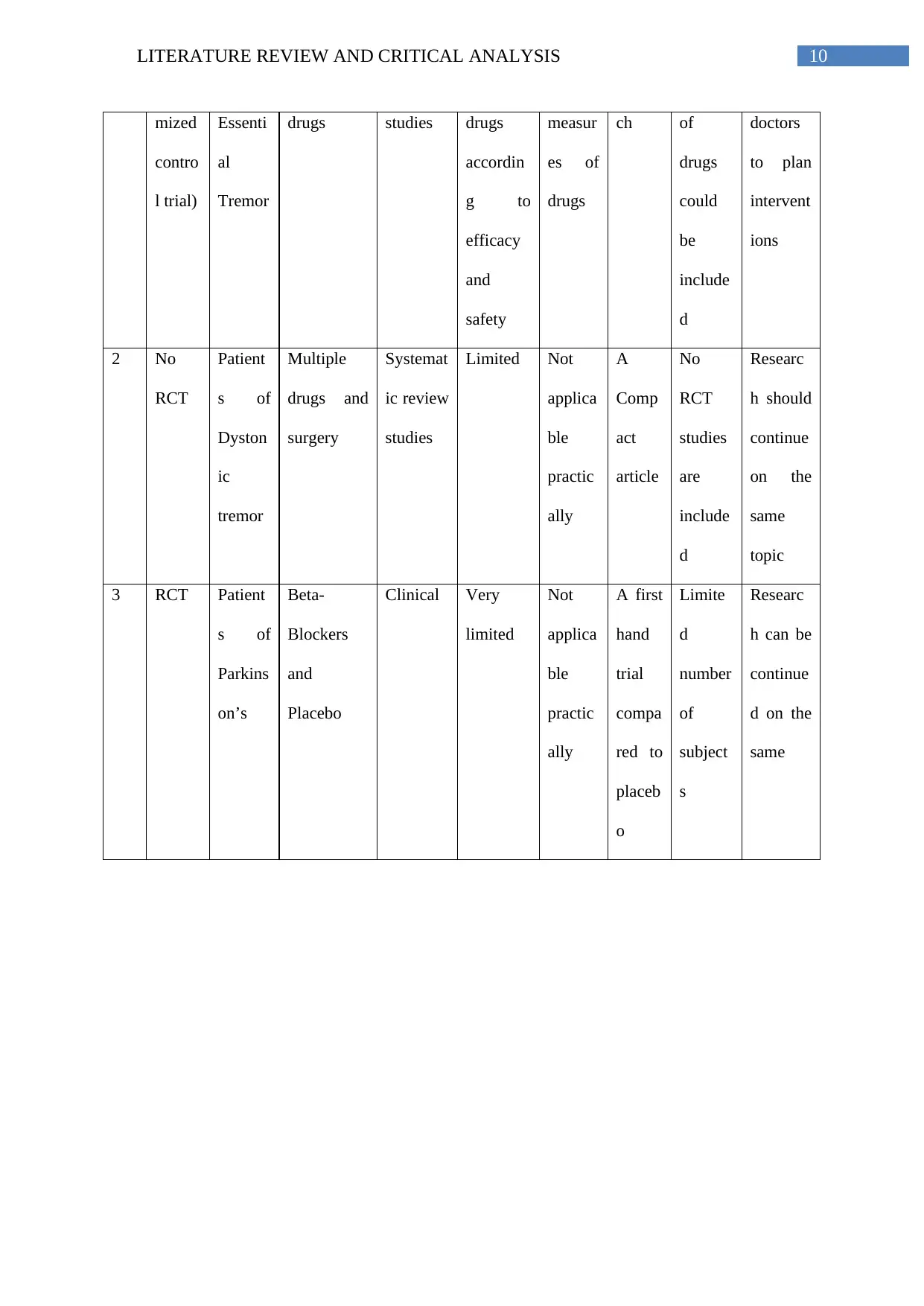
10LITERATURE REVIEW AND CRITICAL ANALYSIS
mized
contro
l trial)
Essenti
al
Tremor
drugs studies drugs
accordin
g to
efficacy
and
safety
measur
es of
drugs
ch of
drugs
could
be
include
d
doctors
to plan
intervent
ions
2 No
RCT
Patient
s of
Dyston
ic
tremor
Multiple
drugs and
surgery
Systemat
ic review
studies
Limited Not
applica
ble
practic
ally
A
Comp
act
article
No
RCT
studies
are
include
d
Researc
h should
continue
on the
same
topic
3 RCT Patient
s of
Parkins
on’s
Beta-
Blockers
and
Placebo
Clinical Very
limited
Not
applica
ble
practic
ally
A first
hand
trial
compa
red to
placeb
o
Limite
d
number
of
subject
s
Researc
h can be
continue
d on the
same
mized
contro
l trial)
Essenti
al
Tremor
drugs studies drugs
accordin
g to
efficacy
and
safety
measur
es of
drugs
ch of
drugs
could
be
include
d
doctors
to plan
intervent
ions
2 No
RCT
Patient
s of
Dyston
ic
tremor
Multiple
drugs and
surgery
Systemat
ic review
studies
Limited Not
applica
ble
practic
ally
A
Comp
act
article
No
RCT
studies
are
include
d
Researc
h should
continue
on the
same
topic
3 RCT Patient
s of
Parkins
on’s
Beta-
Blockers
and
Placebo
Clinical Very
limited
Not
applica
ble
practic
ally
A first
hand
trial
compa
red to
placeb
o
Limite
d
number
of
subject
s
Researc
h can be
continue
d on the
same

11LITERATURE REVIEW AND CRITICAL ANALYSIS
References:
Baumann, C.R., 2012. Epidemiology, diagnosis and differential diagnosis in Parkinson's
disease tremor. Parkinsonism & related disorders, 18, pp.S90-S92.
Crosby NJ, Deane K, and Clarke CE. 2003 Beta-blocker therapy for tremor in Parkinson's
disease. Cochrane Database of Systematic Review (3) pp.1-8
Fasano, A., Bove, F. and Lang, A.E., 2013. The treatment of dystonic tremor: a systematic
review. J Neurol Neurosurg Psychiatry, pp.jnnp-2013.
Gallego, J.Á., Rocon, E., Belda-Lois, J.M. and Pons, J.L., 2013. A neuroprosthesis for tremor
management through the control of muscle co-contraction. Journal of neuroengineering and
rehabilitation, 10(1), p.36.
Jiménez, M.C. and Vingerhoets, F.J., 2012. Tremor revisited: treatment of PD
tremor. Parkinsonism & related disorders, 18, pp.S93-S95.
Kim, S.D., Yiannikas, C., Mahant, N., Vucic, S. and Fung, V.S., 2014. Treatment of proximal
upper limb tremor with botulinum toxin therapy. Movement Disorders, 29(6), pp.835-838.
Louis, E.D., 2012. Treatment of essential tremor: are there issues we are
overlooking?. Frontiers in neurology, 2, p.91.
Louis, E.D., Huey, E.D., Gerbin, M. and Viner, A.S., 2012. Depressive traits in essential
tremor: impact on disability, quality of life, and medication adherence. European journal of
neurology, 19(10), pp.1349-1354.
References:
Baumann, C.R., 2012. Epidemiology, diagnosis and differential diagnosis in Parkinson's
disease tremor. Parkinsonism & related disorders, 18, pp.S90-S92.
Crosby NJ, Deane K, and Clarke CE. 2003 Beta-blocker therapy for tremor in Parkinson's
disease. Cochrane Database of Systematic Review (3) pp.1-8
Fasano, A., Bove, F. and Lang, A.E., 2013. The treatment of dystonic tremor: a systematic
review. J Neurol Neurosurg Psychiatry, pp.jnnp-2013.
Gallego, J.Á., Rocon, E., Belda-Lois, J.M. and Pons, J.L., 2013. A neuroprosthesis for tremor
management through the control of muscle co-contraction. Journal of neuroengineering and
rehabilitation, 10(1), p.36.
Jiménez, M.C. and Vingerhoets, F.J., 2012. Tremor revisited: treatment of PD
tremor. Parkinsonism & related disorders, 18, pp.S93-S95.
Kim, S.D., Yiannikas, C., Mahant, N., Vucic, S. and Fung, V.S., 2014. Treatment of proximal
upper limb tremor with botulinum toxin therapy. Movement Disorders, 29(6), pp.835-838.
Louis, E.D., 2012. Treatment of essential tremor: are there issues we are
overlooking?. Frontiers in neurology, 2, p.91.
Louis, E.D., Huey, E.D., Gerbin, M. and Viner, A.S., 2012. Depressive traits in essential
tremor: impact on disability, quality of life, and medication adherence. European journal of
neurology, 19(10), pp.1349-1354.
⊘ This is a preview!⊘
Do you want full access?
Subscribe today to unlock all pages.

Trusted by 1+ million students worldwide
1 out of 14
Related Documents
Your All-in-One AI-Powered Toolkit for Academic Success.
+13062052269
info@desklib.com
Available 24*7 on WhatsApp / Email
![[object Object]](/_next/static/media/star-bottom.7253800d.svg)
Unlock your academic potential
Copyright © 2020–2025 A2Z Services. All Rights Reserved. Developed and managed by ZUCOL.





